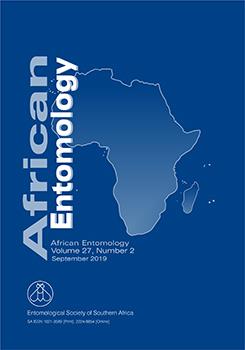The genus Rhynchophorus (Herbst 1795) (Coleoptera: Curculionidae) is a key pest of palms worldwide, but information on Rhynchophorus spp. attacking the oil palm, Elaeis guineensis Jaquin in Uganda is outdated. This study was carried out to establish the diversity, distribution and incidence of Rhynchophorus spp. on E. guineensis at three production set-ups namely large-scale plantations, adaptive trials and small-scale farms in three (Lake Victoria Crescent, Lake Albert Crescent and Western Highlands) agro-ecological zones in Uganda; and to establish the effect of vicinity to natural vegetation on incidence of the pest. Two surveys were conducted in 2018 during the dry and wet seasons. Oil palm trees in each study site were scored as infested (1) or not infested (0) with Rhynchophorus spp. Heavily infested oil palms were sampled to collect weevils for morphological identification and were found to be of only one species, Rhynchophorus phoenicis(Fabricius, 1801). Incidence of R. phoenicis was compared across sampling sites, season and proximity to natural vegetation; and subjected to a multiple linear regression with temperature, relative humidity and rainfall. Incidence of R. phoenicis was highest in Masaka district in the western side of River Nile in Lake Victoria Crescent agro-ecological zone; and absent in Mayuge and Bugiri district at the eastern side of River Nile in Lake Victoria Crescent agro-ecological zone. The pest incidence was higher in the wet than the dry season; and in fields far away from natural vegetation than those that were nearer. Mean incidence of R. phoenicis did not correlate with temperature, relative humidity and rainfall. These findings offer clues of factors to consider in designing strategies for managing R. phoenicis in Uganda.
How to translate text using browser tools
4 October 2019
Distribution and Incidence of the Oil Palm Weevil Rhynchophorus phoenicis (Fabricius, 1801) (Coleoptera: Curculionidae) in Selected Agro-Ecological Zones of Uganda
J. Baguma,
M. Otema,
G. Ddamulira,
R. Naluyimba,
J.P. Egonyu
ACCESS THE FULL ARTICLE
It is not available for individual sale.
This article is only available to subscribers.
It is not available for individual sale.
It is not available for individual sale.

African Entomology
Vol. 27 • No. 2
October 2019
Vol. 27 • No. 2
October 2019
adaptive trials
incidence
natural vegetation
season
weather





